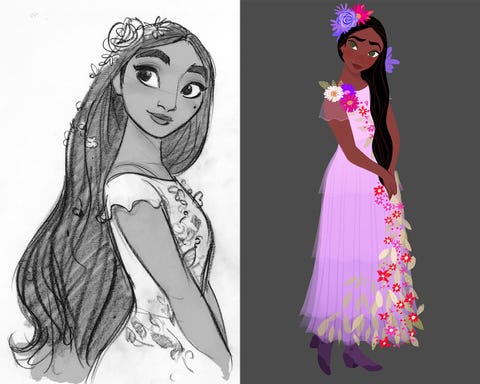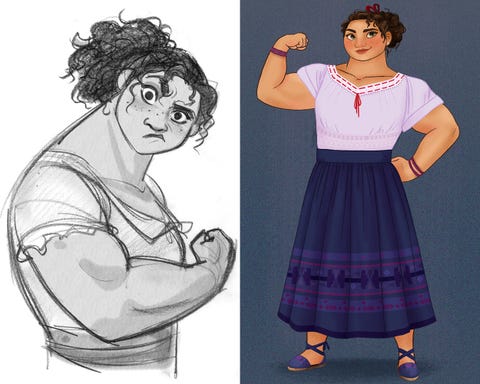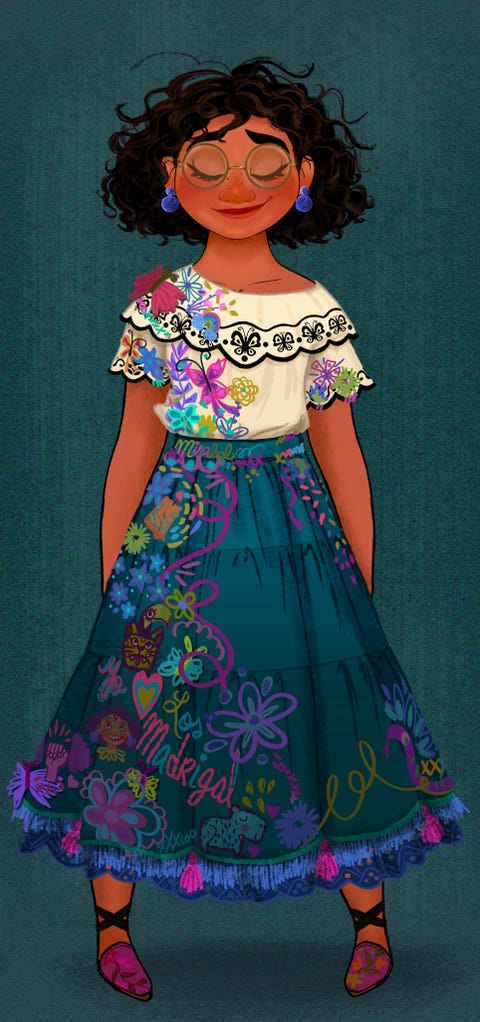There’s no phrase that captures the zeitgeist quite like “We Don’t Talk About Bruno.” For anyone living under a rock—or a magical house, for that matter—the much-memed line comes from Disney’s Encanto, which became a streaming sensation over the holidays and even secured three Oscar nominations. With a soundtrack helmed by Lin-Manuel Miranda and a story to tenderize the toughest of hearts, the film, which centers on a large Colombian family with supernatural powers and the one daughter without them, has become the obsession of toddlers, parents, and TikTokkers alike.
While “Bruno” is a certified earworm, it’s Encanto’s dazzling look—and vibrant clothing—that make the film really sing. (Think traditional A-line skirts, smocked blouses, bandeau headbands, and lots of embroidery.) To learn about what went into the Madrigal family’s wardrobe, we caught up with Neysa Bove, Encanto’s costume design lead, and her sister Lorelay, the film’s associate production designer, who have also worked on past Disney projects like Moana and The Princess and the Frog, respectively. Together, we discussed color, character, cultural fidelity, and yes, Bruno.
Walk me through the design process for the film. How did it go from sketch to screen?
Lorelay Bove: It always starts with the script. Since day one, the directors wanted to have a very big, diverse Colombian family. There were a lot of challenges; mainly, how can we guide the audience so they’re not confused? I thought it would be fun to divide each side of the family into a color palette. We had Mirabel’s side of the family, with Julieta and Augustín and the sisters, all in cooler jewel tones. On the opposite side, you have Pepa and Félix. They’re really fun, and Félix has his roots in the Afro-Colombian community in the Caribbean, so for them we thought warm colors: yellows, oranges, a little bit of red.
Neysa Bove: The color palette helps the viewer understand the story because you’re watching a scene, and subconsciously, you start to understand who’s who. Because the song goes so fast! Color was a beautiful solution. And then from there, we’d start adding little pieces. Mirabel’s skirt has all this embroidery inspired by all the sides of the magical family, so her skirt has all the warm and cool tones.
LB: I created a little line-up of all the characters and their skin tone. We had many diverse characters, and we wanted to make sure we were really representing those communities. Early on, Neysa had asked for consultants that were experts from Colombia. So we got an anthropologist, a botanist…
NB: I actually talked to the botanist for Isabela’s costume. I think it’s so crucial to get people from where you’re getting inspired by in a film so they can really talk about what’s important. We’re lucky to have that source to make it feel authentic, not only for the viewer but for the people that are from there. We wanted there to be things that feel familiar to them.
What specific elements did the consultants help bring to the costumes?
LB: Our main consultants, Juan [Rendón] and Natalie [Osma, from the Colombian Cultural Trust], would oversee all our design work every week. They were part of the team, and they were very specific. We also had Lili [journalist Edna Liliana Valencia Murillo], who was an Afro-Caribbean consultant, and she played a huge part in our work on Félix, Dolores, and Antonio.
NB: I was mainly inspired by folkloric costumes in Colombia. Each region has a specific folkloric festival or dance; they have Bambuco in a region of Colombia, and there’s a flower festival as well. For the Bambuco dance, the women wear these dresses with all these flowers, and I got so inspired for Isabela. But we also had to always keep in mind: we’re not doing a historical documentary; we’re doing a musical, and we’re trying to tell the story of this family. We need to serve the story first, always. It’s always really challenging but interesting to work on a piece that’s inspired by an actual place.
LB: This has the right balance. We had the consultants, but we also added the elements of the magical gifts to each outfit. You see Julieta with the spices and all the herbs she uses to cure—that’s all embroidered in her skirt. When you see Luisa, she has dumbbells and weights embroidered in her skirt. Antonio has a vest and it’s all covered with animals. Pepa’s dress has droplets of water and lightning because she controls the weather. Dolores is the one that hears, and she has soundwaves embedded everywhere in her costume. Each character, depending on their gift, will have a little bit of nuance designed into their costume.
Can you tell me more about Mirabel’s look? What was behind those green glasses?
LB: Since day one, the directors wanted to have a character with glasses. The idea behind that was the theme of perspective. And since the beginning, they wanted her to have that short hair; they wanted her to be quirky and different and fun. Early on, we came up with, ”Well, what if she embroidered her skirt and it was kind of messy?” And then Neysa came up with the beautiful iconography based on each family member’s gift.
NB: We have working scripts and treatments that we read so we get to know a little more about the characters. One thing about Mirabel is that she has no power, so she wants to stand out from the rest of the magical family. That’s why her garment is so loud, if you compare it to the others. It’s not subtle. That’s her way of saying, “I’m here!” Ultimately, though, she’s also doing an ode to her family with the embroidery. It’s like when you’re an athlete and you’re wearing your team’s jacket—she’s doing that, but with her family. She’s their biggest fan.
LB: All the iconography that’s on her skirt—it’s almost like a young woman at school doing sketches in her diary. This is her way of showing her love for them.
NB: For the blouse, I was inspired by this area in the coffee region where they have a festival of Vélez. They have these blouses that typically have black embroidery on top of the collar. When Colombian people watch, they recognize that. With other characters, you see a lot of those A-line-type skirts that they’d recognize too. Many of them have petticoats underneath with eyelet cotton embroidery within them, and that’s a very traditional thing.
How did this compare to other projects you’ve worked on for Disney?
NB: We’re always trying to really dive in and not make something generic, but Encanto was the most in-depth one I’ve worked on due to the amount of characters onscreen. With Moana, we had Moana and Maui, and a few others sprinkled in. But here we have a family of twelve.
LB: Also, the type of clothing is loose. You’re maybe used to seeing movies where the characters wear almost neoprene-like fabrics, but in this one, we wanted to do the opposite. We wanted to make the clothes look like the clothes in Colombia. A lot of detail was put into the embroidery, into the textures, the movement. Everything is very tactile, and I think the audiences feel it.
NB: For all of the costumes, except maybe Isabela’s because she’s the perfect sister, there’s a sort of asymmetry to them. There’s a handmade quality; we never wanted it to feel manufactured. It really feels like a craftsman made it.
That’s part of what makes the movie feel so unique. It’s not a princess movie; the characters, particularly the girls and women, are nuanced.
LB: And people can connect with that. I hope audiences stop the frame on each of the details, because they’ll find all these little surprises.
I know we don’t talk about Bruno, but I want to talk about Bruno. What went into designing his character? How did you depict him as someone who is both feared and, ultimately, beloved?
NB: We had a team of designers, and Bruno’s costume was done by a designer named Meg Park. Because he’s a fortune-teller of sorts, when we were talking to her originally, he had this garment that was like a robe that you would see a fortune-teller wearing in maybe the 1900s. But then when we talked to our team of experts in Colombia, they had us look at a few different traditional ponchos, and that’s what really brought it back to the Colombian influence.
LB: We picked emerald green for Bruno because in Colombia, they have mines of emeralds, and there’s this idea that emerald, in many cultures, is sort of like an amulet. Some civilizations in the past have used it to predict the future. We talked to the consultants and we decided the Quimbaya of Pre-Columbian culture would be a great resource for him. We looked at that and designed the sand clock hourglass and different iconography for him throughout his poncho.
This content is imported from YouTube. You may be able to find the same content in another format, or you may be able to find more information, at their web site.
NB: One little bit about Bruno: The guy is weird! He’s been locked up inside of the house for a long time living with his rat buddies. You can see there are these little chewed up holes in his poncho that clearly the rats got into.
LB: He’s been there for however many years and he’s never washed his clothes.
NB: It’s in his appearance, too. He’s not been in the sun for a long time, so he has sort of a desaturated grayish tone to his skin, and then later we did the opposite. When he gets out and he’s more a part of the family, he’s a little more made up.
Obviously, you’re sisters, and Encanto is a movie all about family. Did that add a special layer to the design process for you?
LB: For sure. We’re very hard on each other, but we love working together. It’s the first time we’ve worked together, so it was a special project.
NB: The sibling relationships really hit me when we actually watched the finished film. I just felt like, wow, I’m the Mirabel in my family. I’m a twin, so my twin and I always look up to our older sister Lorelay [Laughs]. She’s like the Isabela in our family. Overall, it was really emotional to watch, and to see all the work we’ve put into it on the screen.
This interview has been edited and condensed for clarity.
This content is created and maintained by a third party, and imported onto this page to help users provide their email addresses. You may be able to find more information about this and similar content at piano.io



